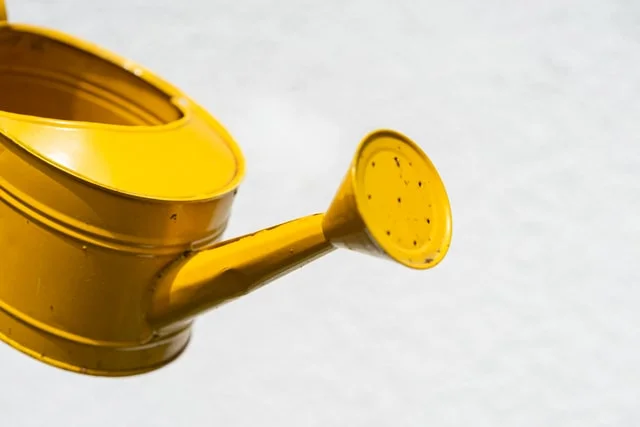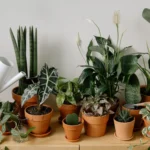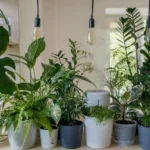One important part of taking care of a plant is to water it. As long as you don’t over or under water your plant, you’ll have a flourishing plant.
If you’ve ever read any recommendations on how to properly care for plants, you’ve probably come across the terms “top watering” and “bottom watering.” What exactly does each of these phrases mean? Why should you choose to perform either of these things rather than the other? Which of these would be most beneficial to your plants? In this plant care guide,
I’ll provide answers to all of these excellent questions, allowing you to make an informed decision about what’s best for your plant.
Table of Contents
What exactly is the distinction between top watering and bottom watering?
Top watering is when you water your plant from the top of the soil, whereas bottom watering is when you water your plant from the bottom of the container.
The most typical technique to water a plant is from the top, therefore it’s extremely probable that you’ve been doing it this way. When you water your plant by using a watering can to sprinkle water on top of the soil and then allowing it to seep down into the soil, this is referred to as top watering.
The process of watering from the bottom is a little bit different. When you bottom water, you use a bucket or a saucer, something that can hold the water without making a mess. You start by pouring water into the bottom of the bucket or saucer, then placing the plant together with its container in the water.
Bottom watering is only possible if the container that your plant is in has a drainage hole. This is because the drainage hole is the only method for the water to reach the soil below the plant. The water in the saucer or bucket is progressively absorbed by the soil in the container.
In about 5 minutes, the soil will have absorbed all of the water that it is capable of holding. After allowing the soil to first soak up the water, you may then remove it from the water and let the plant to slowly lose any surplus moisture through its leaves.
Bottom watering has several advantages to top watering, but what exactly are they?
The Benefits of Bottom Watering
If you water your plants from the bottom, there are a few advantages to watering them from the top.
All of the labor is done by the soil.
The best approach to water your plant without allowing any excess water to collect at the base of the pot is to use the bottom watering technique. You won’t be able to overwater your plant if you water it from the bottom up and don’t let it rest in the water for longer than five minutes at a time.
After removing the soil from the water and allowing it to drip for a further five minutes, you will be able to determine with absolute certainty that the soil possesses the optimal level of moisture.
Pest control
When you water your plant from the bottom up, the top layer of soil never gets wet, which is another benefit of this method. You may protect your plant from fungus, insects, and other harmful organisms by adding a layer of dry dirt on top of the existing soil. All of these unwanted critters are drawn to damp places and flourish in climates with high relative humidity. You may make the atmosphere around your plant less enticing for those pests by watering it from the bottom up.
Are there any drawbacks to bottom watering your plant? In the next part, we’ll find out!
The problems that might arise from bottom watering
Bottom watering is one of those things that, like most things, has both benefits and drawbacks. Let’s find out what the most significant drawbacks are to watering your plants from the bottom up.
Salts remain behind
To begin, one of the most significant drawbacks of bottom watering is the fact that you will never be able to get enough drainage of any salts from your soil. When you water your plant from the top, you are not only watering your plant, but you are also draining any remaining salts from the fertilizer to the bottom of the pot.
This is because you are watering the plant from the top. If you have a container that has a drainage hole, which is something that I highly encourage, then the water that you use to water your plant will also clean the environment in which it is growing.
When you constantly water the plant from the bottom, you won’t be able to remove these salts from the soil as effectively as you would want. It is for this reason that it is a fantastic idea to mix watering your plants from the top and from the bottom.
When you combine the two methods of watering, not only do you ensure that your plant is getting the right amount of moisture, but you also clean the environment in which it is developing.
Less control
The second disadvantage of watering your plant from the bottom up is that the soil will take up all the available moisture and become completely dry. this will work perfectly if you do. You will, however, kill your plant by overwatering it if you try to cultivate a cactus in soil that was not formulated for the growth of cacti.
When you water your plant from the surface of the soil, you have a great deal of control over the total amount of moisture that you provide it.
Conclusion
We have discovered what the key difference is between “top-watering” and “bottom-watering” a plant. We have also gained an understanding of the benefits and drawbacks associated with watering your plants from the bottom up. If you are using the appropriate soil for your plant and you want to assist in the prevention of pests on or around your plant, bottom watering is a terrific method to utilize.
Yet, you mustn’t only water your plants from the bottom since you still need to drain away the salts that are left behind by your fertilizer. If you simply water your plants from the bottom, you won’t get rid of the salts.
When you water your plant using a combination of top watering and bottom watering, you ensure that the growth environment for your plant is kept clean and that it receives an adequate amount of moisture. This makes it easier for you to provide your plant with the optimal growth conditions it requires to flourish, enabling it to become robust and large.
I appreciate you taking the time to read my article. I really hope that this information is of use to you in maintaining the health and beauty of your plants.
Frequently Asked Questions
What is bottom watering for plants?
Bottom watering refers to watering your plants by allowing water to soak up through the soil at the bottom of the pot rather than allowing water to sink through the soil at the top.
Is bottom watering better for your plants?
Bottom watering keeps your plants from drowning in their container. The soil can only keep as much water as it can absorb. It also keeps pests away by keeping the top layer of soil dry when watering your plant.
Is bottom watering bad for your plant?
It’s not a terrible idea to water your plants from the bottom, unless that’s the only method you use. If you water your plant from the bottom up, any residual salts from the fertilizer will be trapped inside the pot and won’t be able to evaporate. You may assist your plant grow by draining the salts, which you can do by combining this method with top watering.
Photo by Markus Winkler on Unsplash



